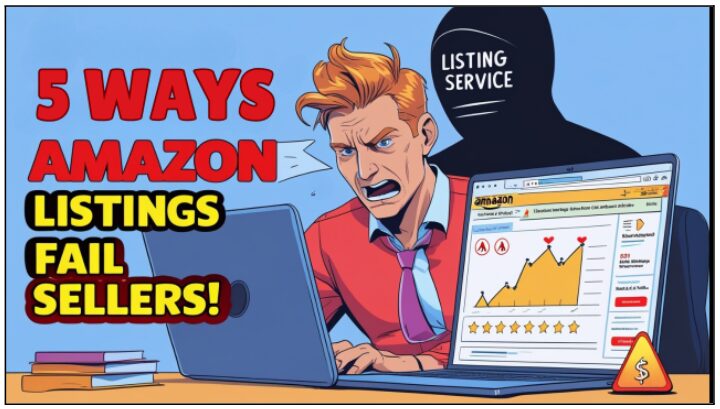5 Ways Amazon Listing Services Fail Sellers and How to Spot Them

Navigating the Amazon marketplace is like weaving through a chaotic Delhi market—loud, competitive, and packed with challenges. With millions of sellers fighting for customer attention, your product listings need to be razor-sharp to stand out. That’s where Amazon listing services swoop in, promising to optimize your listings, boost visibility, and send your sales soaring. Sounds like a dream, right? But not every service is a hero. Some Amazon product listing services can flop hard, leaving you with suppressed listings, drained budgets, or even a banned account.
In this blog, we’re diving into five common ways Amazon listing services fail sellers and sharing practical tips to spot the duds before they wreck your business. Whether you’re a rookie seller or a seasoned pro, this guide will help you pick a legit service and dodge the traps. Let’s get started!
Why Sellers Trust Amazon Listing Services
Before we unpack the failures, let’s talk about why Amazon listing services are such a big deal. Creating a high-converting listing isn’t like tossing up a quick social media post. It’s a complex grind that involves:
- Keyword research : Pinpointing search terms that drive traffic.
- Compelling content : Writing titles, bullet points, and descriptions that hook buyers.
- Professional visuals : Crafting images and videos that meet Amazon’s strict rules.
- Backend optimization : Using hidden search terms to boost discoverability.
For sellers managing various products or new to the market, this can seem like solving a puzzle with some parts missing. That’s where Amazon catalogue services come in, offering expertise and tools to make your listings pop. But when these services mess up, the fallout can be brutal. Below, we break down five ways they fail sellers—and how to spot the warning signs.
1. Ignoring Amazon’s Compliance Rules
One of the biggest ways Amazon listing services drop the ball is by ignoring Amazon’s strict guidelines. From image requirements to content rules, Amazon’s policies are non-negotiable. Not adhering to the rules may result in hidden listings, missed sales, or account suspensions.
The Problem
Some Amazon product listing services either don’t understand Amazon’s rules or deliberately cut corners. They might upload images with text overlays, stuff keywords into titles, or use banned phrases like “limited-time offer.”
Real-World Example
Priya, a Mumbai seller of skincare products, hired a service that added flashy text to her main product images. Amazon flagged them for non-compliance (main images need white backgrounds, no text), delisting her products during a peak sales season. Priya lost ₹1.5 lakh in revenue and had to redo her visuals from scratch.
How to Spot It
- Ask About Compliance : Quiz the service on how they ensure listings meet Seller Central guidelines. Unclear or indifferent responses are a warning sign.
- Review Their Work : Before approving changes, check images, titles, and descriptions against Amazon’s rules.
- Monitor Alerts : If Amazon sends compliance warnings after the service’s work, it’s a sign they’re not following the playbook.
2. Using Outdated Optimization Tactics
Amazon’s platform develops more swiftly than social media trends. Tactics that worked a few years ago can now tank your rankings. Unfortunately, some Amazon listing services are stuck in the past, using outdated strategies that don’t align with Amazon’s current algorithm.
The Problem
In 2025, Amazon’s A10 algorithm emphasizes relevance, user experience, and succinct content. Old-school tactics like 300-character titles or generic keyword lists are ineffective. Services that haven’t updated their approach leave your listings buried in search results, letting competitors steal the show.
Real-World Example
Rohan, a Bangalore seller of kitchen gadgets, hired a service that packed his titles with repetitive keywords. His listings tanked because Amazon now caps titles at 200 characters and favors natural, intent-based keywords. Rohan wasted three months and ₹80,000 before switching to a modern service.
How to Spot It
- Ask About Algorithm Trends : A good service should know A10’s focus on relevance and shorter titles. If they mention “keyword stuffing,” turn around and leave.
- Request a Sample : Ask for a sample title or keyword plan. It should feel natural, not like a keyword dump.
- Track Rankings : If your listings aren’t climbing after a month, the service’s tactics might be outdated.
3. Lack of Transparency in Their Process
Transparency is critical when you’re trusting someone with your Amazon business. Some Amazon catalogue services operate like they’re running a covert mission, making changes without explaining what or why.
The Problem
These services might tweak keywords, rewrite descriptions, or adjust pricing without your input. This leaves you clueless about whether their work is compliant or effective. If they mess up, you’re the one facing Amazon’s penalties, not them.
Real-World Example
Vikram, a Pune seller of pet supplies, hired a service that slashed his prices and added irrelevant keywords (like “dog collar” for cat toys) without telling him. His sales crashed, and he only noticed after customers complained. The service called their process “proprietary,” leaving Vikram to fix ₹2 lakh in damages.
How to Spot It
- Demand Regular Updates : A legit service shares keyword reports, content changes, and performance metrics. If they’re secretive, it’s trouble.
- Request Previews : Ask to see drafts of titles, descriptions, or images before they go live.
- Watch for Unexplained Changes : If your listings suddenly change or prices shift without your approval, confront the service ASAP.
4. Overpromising and Under-Delivering
Some Amazon listing services lure sellers with shiny promises like “guaranteed page-one rankings” or “triple your sales in a week.” These claims sound amazing, but are impossible to deliver consistently.
The Problem
Amazon’s algorithm is dynamic and influenced by competition, customer behavior, and market trends. No service can guarantee specific results. When these services fail to deliver, you’re left with a lighter wallet, no progress, and sometimes a long-term contract you can’t escape.
Real-World Example
Aarti, a Hyderabad seller of jewelry, paid ₹1 lakh for a service that promised top rankings in 10 days. A month later, her listings were stuck on page 10. The service blamed “market conditions,” but Aarti found they’d used generic templates and minimal keyword research.
How to Spot It
- Beware of Guarantees : Ethical services focus on optimization, not impossible promises.
- Scrutinize Contracts : Avoid long-term deals without a trial period.
- Ask for Proof : Request case studies or data from past clients. If they can’t share, they’re likely overhyping.
5. Pushing Shady Tactics Like Fake Reviews
The most dangerous failure is when Amazon listing services push unethical tactics, like fake or incentivized reviews, to “boost credibility.” This is a direct violation of Amazon’s policies and can lead to severe consequences.
The Problem
Some services offer “review-building” packages, connecting sellers with “review networks” or suggesting free products for five-star feedback. Amazon’s fraud detection catches these schemes, resulting in suppressed listings, lost Buy Box eligibility, or account bans.
Real-World Example
Neha, a Delhi seller of organic teas, fell for a service’s “review enhancement” package. They delivered 30 five-star reviews in a week, but Amazon flagged them as fake. Neha’s account was suspended for two months, costing her ₹3 lakh in sales and appeal fees. The service vanished when she asked for a refund.
How to Spot It
- Listen for Review Red Flags : Terms like “guaranteed reviews” or “review communities” are dealbreakers.
- Check Review Patterns : Sudden spikes in reviews, especially from unverified buyers, signal trouble. Monitor your analytics in Seller Central.
- Ask About Ethics : Directly ask how they handle reviews. A legit service emphasizes authentic feedback and compliance.
Why These Failures Happen
Why do Amazon listing services keep tripping up? Here’s the breakdown:
- Lack of Amazon Expertise : Some services are general e-commerce players who don’t grasp Amazon’s unique rules and algorithms.
- Profit-Driven Motives : Shady providers prioritize quick cash over your long-term success, cutting corners or pushing risky tactics.
- Generic Approaches : One-size-fits-all strategies fail when products, categories, and marketplaces (e.g., Amazon India vs. US) have different needs.
- Outdated Knowledge : Services that don’t stay updated with Amazon’s frequent changes deliver ineffective results.
- Poor Communication : Failing to involve sellers in the process leaves them vulnerable to errors or violations.
How to Choose a Trustworthy Amazon Listing Service
Not all Amazon product listing services are flops. Many are ethical, skilled, and worth their weight in gold. Here’s how to find a winner:
Research Their Track Record
Check reviews, testimonials, or ask other sellers for recommendations. A solid service has happy clients, not a history of complaints.
Quiz Them on Compliance
Ask how they ensure listings meet Amazon’s guidelines. They should know image rules, content policies, and category-specific requirements like the back of their hand.
Demand Transparency
You should get regular updates, keyword reports, and a clear breakdown of changes. No secrets or “proprietary” excuses.
Look for Customization
A good service tailors strategies to your product, category, and marketplace. Avoid cookie-cutter plans that ignore your niche.
Verify Amazon Expertise
They should specialize in Amazon, not just e-commerce, and stay current with A10 algorithm trends and Seller Central updates.
Start with a Trial
Test them with one listing to gauge their work. If they deliver compliant, effective results, scale up. If not, you’ve saved your budget.
DIY Tips to Protect Your Listings
If you’re wary of Amazon catalogue services or want to keep tabs on their work, here are practical ways to stay safe:
Study Seller Central
Amazon’s guidelines on images, content, and reviews are your go-to resource. Bookmark them and check for updates regularly.
Leverage Amazon’s Tools
Use Brand Analytics, Search Term Reports, and Listing Quality Dashboard to guide your optimization without breaking rules.
Audit Listings Regularly
Every month, review your titles, images, and descriptions for compliance and performance. Watch for Amazon warnings or suppressed listings.
Stay Informed
Follow Amazon-focused blogs, webinars, or seller forums to keep up with best practices and algorithm changes.
Trust Your Instincts
If a service’s tactics feel sketchy—like they’re hiding details or pushing quick fixes—don’t ignore the warning signs.
Final Thoughts: Steer Clear of Amazon Listing Service Fails
A reliable Amazon listing service can be your ticket to dominating the marketplace, with optimized listings and booming sales. But as we’ve seen, the wrong service can fail you in big ways—ignoring compliance, using outdated tactics, hiding their process, overpromising results, or pushing dangerous review schemes. These missteps don’t just waste your money; they can jeopardize your entire Amazon business.
To dodge the duds, do your homework. Vet Amazon product listing services like you’re hiring a key employee—check their reputation, demand transparency, and ensure they know Amazon’s rules inside out. If you’re already working with a service, monitor their work and audit your listings regularly. Your Amazon account is your livelihood, so don’t let a bad service turn it into a nightmare.
Have you dealt with a flaky Amazon catalogue service or found a gem that delivered? Post your story in the comments—I’m eager to listen! And if you need help picking a legit service or fixing a listing gone wrong, drop me a line. Let’s ensure your Amazon business remains successful and free from setbacks!



